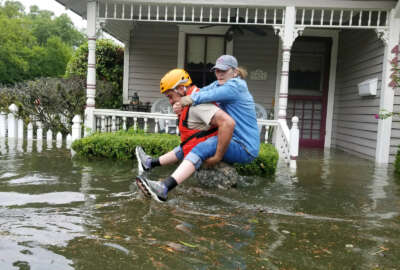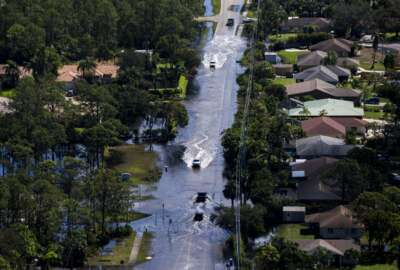
Feds from all Cabinet agencies can now apply to help DHS with Harvey, Irma response
Federal employees from other Cabinet agencies can apply to join the Homeland Security Department's Surge Capacity Force, a voluntary program that deploys non-FE...
This story has been updated Thursday, Sept. 21 to add additional information from Corey Coleman, FEMA’s chief component human capital officer.
The Homeland Security Department is opening up its Surge Capacity Force to other employees outside of DHS to help with the federal response to the aftermath of Hurricanes Harvey and Irma.
DHS Acting Secretary Elaine Duke sent a memo to Cabinet agencies last week, describing how other departments could help recruit their own to join the Surge Capacity Force, a voluntary program that deploys non-FEMA employees to support particular disaster recovery efforts.
The memo directs each Cabinet agency to designate a “point person” to help spread the word to about the force to their respective workforces, accept applications from interested employees and register them for the SCF with FEMA.
Federal employees at those agencies will start to see signs and emails about the program. If they haven’t seen emails from their individual agencies, interested employees can email surgecapacityforce@fema.dhs.gov to apply and join the force’s ranks.
About 6,500 non-FEMA DHS employees are registered volunteers with the surge capacity program. The department had always intended to expand the SCF to employees outside of DHS when it first stood up the surge capacity force, but the acting secretary’s latest memo now fulfills that intention.
A DHS spokeswoman said the federal community had shown interest in the SCF program, and there was no better time to expand the Surge Capacity Force to others.
DHS hopes to deploy at least 2,000 SCF volunteers for Harvey and Irma response, the department said.
“The devastation we have seen in the aftermaths of the recent hurricanes is extraordinary, and our federal support to the collective recovery effort to these regions needs to be equally extraordinary,” DHS said in a statement to Federal News Radio. “There is a unique opportunity at hand for eligible individuals to voluntarily deploy to these disaster regions to work alongside FEMA, state and locals and countless others.”
Interested federal employees must have an HSPD-12 Personal Identity Verification (PIV) and a government-issued travel card to be eligible to join the force. In addition, they must be trained on the requirements of using those travel cards, and they must be able to deploy to the field in 48 hours.
Interested federal employees must first get approval from their manager before traveling to the field. Once they get approval, SCF volunteers can typically deploy to their assignment within a week, Corey Coleman, FEMA’s chief component human capital officer, said during a Government Executive sponsored-panel discussion in Washington Sept. 20.
The department is first sending surge capacity volunteers to a mobilization center in Anniston, Alabama, for training. Classes are scheduled every week.
Surge Capacity Force members will typically help in areas related to logistics, debris monitoring, individual survivor assistance, public outreach, IT, human resources, finance, external affairs, acquisition and planning.
“We’ve done the initial push,” Coleman said. We’re continuing to have communications with the departments. We’re trying to get out a little more guidance to help agencies understand how the process works. We’re prepared to expand the program and bring volunteers in. We’re establishing other staging areas, or staging bases, for individuals to be able to get the training and be able to go out on the front lines.”
Volunteers should flag any special skills that might be useful to the disaster response efforts during the training process, DHS said.
Surge Capacity Force volunteers will spend a maximum of 45 days in the field, but Coleman described the opportunity as a 30-day deployment.
During the first week of the department’s rescue and response efforts in Texas and Louisiana, DHS had been sending SCF volunteers in shifts for a few days.
The SCF will only deploy under the secretary’s orders, and DHS has only activated the Surge Capacity Force once before, when about 1,100 non-FEMA employees supported disaster response and recovery efforts in the aftermath of Hurricane Sandy in 2012.
Congress authorized the program under the Post-Katrina Emergency Management Reform Act of 2006, which was designed to help FEMA better respond to catastrophic incidents.
Copyright © 2024 Federal News Network. All rights reserved. This website is not intended for users located within the European Economic Area.
Nicole Ogrysko is a reporter for Federal News Network focusing on the federal workforce and federal pay and benefits.
Follow @nogryskoWFED
Related Stories





